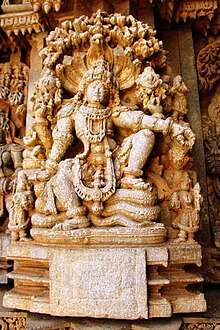Mahavishnu

| Part of a series on |
| Vaishnavism |
|---|
 |
Mahavishnu (Sanskrit: महाविष्णु, romanized: Mahāviṣṇu, lit. 'Great Vishnu') is an aspect of Vishnu, the principal deity in Vaishnavism. In his capacity as Mahavishnu, the deity is known as the Supreme Purusha, the absolute protector and sustainer of the universe, the one who is beyond human comprehension, and all attributes.[1][2]
Literature
The Bhagavata Purana, among the most revered texts among Vaishnavas, attributes the following qualities to Mahavishnu:[3]
All the worlds, from the realm of Brahma included in the Brahmanda (cosmic sphere), are spheres in which experiences conferring Aisvarya (prosperity and power) can be obtained. But they are destructible and those who attain them are subject to return. Therefore destruction, i.e., return is unavoidable for the aspirants for Aisvarya, as the regions where it is attained perish. On the contrary there is no birth to those who attain Me, the Omniscient, who has true resolves, whose sport is creation, sustentation and dissolution of the entire universe, who is supremely compassionate and who is always of the same form. For these reasons there is no destruction in the case of those who attain Me. He now elucidates the time-period settled by the Supreme Person's will in regard to the evolution and dissolution of the worlds up to the cosmic sphere of Brahma and of those who are within them.
— Vyasa, Bhagavata
Role
Mahavishnu is said to lie in the Causal Ocean, or the Garbhodaka.[4] According to Vaishnava cosmogony, he puts the seed of this material universe in Mahamaya by glancing at her. Mahamaya remains the ever obedient material energy of Vishnu. All the natural elements including sky, fire, water, air and land are created along with mind, intelligence and false ego.
After this, Mahavishnu enters each of the many universes so created (seeds emerging from the pores of His skin) as Garbhodaksayi Vishnu, who lays down in each and every of these individual material universes (Brahmanas). It can be interpreted that Garbodakshayi Vishnu is the collective soul of all souls in a particular material universe, and that Mahavishnu is the collective soul of all souls in all of the material universes.
From Garbhodaksayi Vishnu then emerges Brahmā, who is the secondary creator (due to his need to meditate to create planets in the material universe) of the planetary systems within this material universe (Brahmanda).[5]
Gaudiya Vaishnavism
In Gauḍīya Vaishnavism, a school of Vaiṣhṇavism, the Satvata-tantra describes three different forms, or aspects, of Mahavishnu: Karanarnavasayi Viṣhṇu, Garbhodakaśāyī Viṣhṇu and Kṣīrodakaśāyī Vishnu.[6] The term Mahavishnu refers to the absolute truth, Brahman (impersonal invisible aspect) then as Paramatma (Aspect beyond the understanding of human soul), and finally as Sarvatma (incarnating for bringing perfection).[citation needed] Bhakti (loving devotion) is offered to Sarvatman (Krishna or Rama avatars or incarnations of Vishnu, Narayana bringing both peace and perfection of the living beings).[citation needed] In this way, bhakti surpasses even yoga, which is aimed at the Supersoul, Paramatman.[citation needed] Mahavishnu is the Supersoul of all living beings (jivatmas) in all material universes.[citation needed] Karanodaksayi Vishnu is understood to be Sankarsana (form) of the Chatur-vyuha of Narayaņa.[citation needed] It is also often used interchangeably with Vishnu to indicate reverence, as the prefix "Maha" in Vishnu indicates the greatness and the vastness of Narayana.[citation needed] All the deities that bear material form like Shiva and Brahma are considered as a grain of sand in the ocean of Mahavishnu's vishvarupam.[citation needed]
See also
References
- ^ www.wisdomlib.org (29 June 2012). "Mahavishnu, Mahāviṣṇu: 7 definitions". www.wisdomlib.org. Archived from the original on 7 August 2022. Retrieved 10 September 2022.
- ^ The Mystery of the Mahabharata: Vol. II: The Systems of HIndu Philosophy & Religion. India Research Press. p. 274. Archived from the original on 16 February 2023. Retrieved 30 September 2022.
- ^ Tapasyananda, Swami (1 September 2015). Srimad Bhagavata – Vol 4. Lulu Press, Inc. p. 22. ISBN 978-1-329-52606-8. Archived from the original on 16 February 2023. Retrieved 28 July 2022.
- ^ Satish, V. (10 October 2014). Tales of Gods in Hindu Mythology. Partridge Publishing Singapore. ISBN 978-1-4828-2799-6. Archived from the original on 16 February 2023. Retrieved 28 July 2022.
- ^ Vaswani, J. P. (20 June 2019). Stories with a difference from the Bhagavata Purana. Gita Publishing House. ISBN 978-93-86004-23-9. Archived from the original on 16 February 2023. Retrieved 28 July 2022.
- ^ Prabhupāda, A. C. Bhaktivedanta Swami (1980). Śrīmad Bhāgavatam: With the Original Sanskrit Text, Its Roman Transliteration, Synonyms, Translation and Elaborate Purports. Bhaktivedanta Book Trust. ISBN 978-81-89574-80-2. Archived from the original on 1 July 2023. Retrieved 28 July 2022.
External links
- Thousand names of the Supreme (Vishnu Sahasranama Stotram)
- A detailed article by Stephen Knapp


